Honeysuckle
| Honeysuckle | |
|---|---|
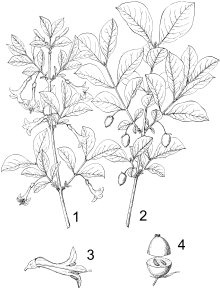 | |
| 1. A flowering branch, 2. A fruiting branch, 3. Longitudinal section of a flower, 4. Fruit cut horizontally. | |
| Scientific classification | |
| Kingdom: | Plantae |
| Clade: | Angiosperms |
| Clade: | Eudicots |
| Clade: | Asterids |
| Order: | Dipsacales |
| Family: | Caprifoliaceae |
| Subfamily: | Caprifolioideae |
| Genus: | Lonicera L. |
| Species | |
|
See text - selected species | |
Honeysuckles (Lonicera, /lɒˈnɪsərə/;[1] syn. Caprifolium Mill.) are arching shrubs or twining vines in the family Caprifoliaceae, native to the Northern Hemisphere. Approximately 180 species of honeysuckle have been identified. About 100 of these species can be found in China and approximately 20 native species have been identified in Europe, 20 in India, and 20 in North America. Widely known species include Lonicera periclymenum (common honeysuckle or woodbine), Lonicera japonica (Japanese honeysuckle, white honeysuckle, or Chinese honeysuckle) and Lonicera sempervirens (coral honeysuckle, trumpet honeysuckle, or woodbine honeysuckle). In North America hummingbirds are attracted to the flowers on some of these plants, especially L. sempervirens and L. ciliosa (orange honeysuckle). Honeysuckle derives its name from the edible sweet nectar obtainable from its tubular flowers.[2] The name Lonicera stems from Adam Lonicer, a Renaissance botanist.
Some species are highly fragrant. Several are cultivated as ornamental garden plants, with numerous cultivars available.
Description
Most species of Lonicera are hardy twining climbers, with a large minority of shrubby habit; a handful of species (including Lonicera hildebrandiana from the Himalayan foothills and L. etrusca from the Mediterranean) are tender and can only be grown outside in subtropical zones. The leaves are opposite, simple oval, 1–10 cm long; most are deciduous but some are evergreen. Many of the species have sweetly scented, bilaterally symmetrical flowers that produce a sweet, edible nectar, and most flowers are borne in clusters of two (leading to the common name of "twinberry" for certain North American species). Both shrubby and vining sorts have strongly fibrous stems which have been used for binding and textiles. The fruit is a red, blue or black spherical or elongated berry containing several seeds; in most species the berries are mildly poisonous, but in a few (notably Lonicera caerulea) they are edible and grown for home use and commerce. Most honeysuckle berries are attractive to wildlife, which has led to species such as L. japonica and L. maackii spreading invasively outside of their home ranges. Many species of Lonicera are eaten by the larvae of some Lepidoptera species—see a list of Lepidoptera that feed on honeysuckles.
Invasive species
Several species of honeysuckle have become invasive when introduced outside their native range, particularly in New Zealand and the United States. Invasive species include L. japonica, L. maackii, L. morrowii, and L. tatarica.
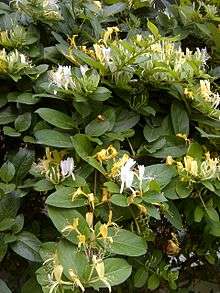
Cultivation
Honeysuckles are valued as garden plants, for their ability to cover unsightly walls and outbuildings, their profuse tubular flowers in summer, and the intense fragrance of many varieties. The hardy climbing types need their roots in shade, and their flowering tops in sunlight or very light shade. Varieties need to be chosen with care, as they can become substantial. Cultivars of the dense, small-leaved L. nitida are used as low, narrow hedges.[3]
The following hybrids have gained the Royal Horticultural Society's Award of Garden Merit:[4]
Other cultivars are dealt with under their species names.
Phytochemicals and sensory effects
Honeysuckle is renowned for its colorful, fragrant flowers[9][10] and variously colored fruit, indicating the presence of complex phytochemicals underlying these properties. Component analyses of berries from 27 different cultivars and 3 genotypes of edible honeysuckle (Lonicera caerulea var. kamtschatica) showed the presence of iridoids, anthocyanins, flavonols, flavanonols, flavones, flavan-3-ols, and phenolic acids.[11] While sugars determine the level of sweetness in the berries, organic acids and polyphenols are responsible for the sour taste and tartness.[11] Some 51 of the same compounds in berries are found in flowers, although the proportions of these compounds varied among cultivars studied.[12]
Interaction with other species
Many insects in the order Lepidoptera visit honeysuckles as a food source. An example of this is the moth Deilephila elpenor. This nocturnal species of moths are primarily attracted to honeysuckles, and they visit the flowers at night to feed on its nectar.[13]
Selected species
Some 180 species of Lonicera are documented:[14]
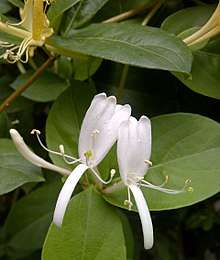
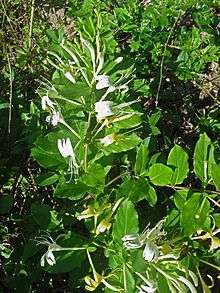
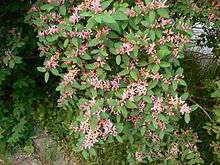

Lonicera acuminata
Lonicera albiflora (white honeysuckle)
Lonicera alpigena (alpine honeysuckle)
Lonicera altmannii
Lonicera angustifolia
Lonicera anisocalyx
Lonicera arborea
Lonicera arizonica (Arizona honeysuckle)
Lonicera biflora
Lonicera bournei
Lonicera brevisepala
Lonicera buchananii
Lonicera buddleioides
Lonicera caerulea (blue-berried honeysuckle)
Lonicera calcarata
Lonicera calvescens
Lonicera canadensis (American fly honeysuckle)
Lonicera caprifolium (goat-leaf honeysuckle, perfoliate honeysuckle. Type species)
Lonicera carnosifolis
Lonicera cerviculata
Lonicera chrysantha (Chrysantha honeysuckle)
Lonicera ciliosa (orange honeysuckle)
Lonicera ciliosissima
Lonicera cinerea
Lonicera codonantha
Lonicera confusa
Lonicera conjugialis (purpleflower honeysuckle)
Lonicera crassifolia
Lonicera cyanocarpa
Lonicera dasystyla (Tonkinese honeysuckle)
Lonicera dioica - (limber honeysuckle)
Lonicera elisae
Lonicera etrusca (Etruscan honeysuckle)
Lonicera fargesii
Lonicera ferdinandii
Lonicera ferruginea
Lonicera flava (yellow honeysuckle)
Lonicera fragilis
Lonicera fragrantissima (winter honeysuckle)
Lonicera fulvotomentosa
Lonicera glutinosa
Lonicera graebneri
Lonicera gynochlamydea
Lonicera × heckrottii (Golden flame honeysuckle)
Lonicera hellenica (Greek honeysuckle)
Lonicera hemsleyana
Lonicera heterophylla
Lonicera hildebrandiana (giant Burmese honeysuckle)
Lonicera hirsuta (hairy honeysuckle)
Lonicera hispida
Lonicera hispidula (pink honeysuckle)
Lonicera humilis
Lonicera hypoglauca
Lonicera hypoleuca
Lonicera implexa
Lonicera inconspicua
Lonicera inodora
Lonicera interrupta (Chaparral honeysuckle)
Lonicera involucrata (bearberry honeysuckle)
Lonicera japonica (Japanese honeysuckle)
Lonicera jilongensis
Lonicera kansuensis
Lonicera kawakamii
Lonicera korolkowii (blueleaf honeysuckle)
Lonicera lanceolata
Lonicera ligustrina
Lonicera litangensis
Lonicera longiflora
Lonicera longituba
Lonicera maackii (Amur honeysuckle)
Lonicera macrantha
Lonicera macranthoides
Lonicera maximowiczii
Lonicera microphylla
Lonicera minuta
Lonicera minutifolia
Lonicera modesta
Lonicera morrowii (Morrow's honeysuckle)
Lonicera mucronata
Lonicera myrtillus
Lonicera nervosa
Lonicera nigra (black-berried honeysuckle)
Lonicera nitida (boxleaf honeysuckle)
Lonicera nubium
Lonicera nummulariifolia
Lonicera oblata
Lonicera oblongifolia (swamp fly honeysuckle)
Lonicera oiwakensis
Lonicera oreodoxa
Lonicera orientalis
Lonicera pampaninii
Lonicera paradoxa
Lonicera periclymenum (honeysuckle, woodbine)
Lonicera pileata (privet honeysuckle)
Lonicera pilosa (Mexican honeysuckle)
Lonicera praeflorens
Lonicera prostrata
Lonicera pyrenaica
Lonicera quinquelocularis
Lonicera reticulata (grape honeysuckle)
Lonicera retusa
Lonicera rhytidophylla
Lonicera rupicola
Lonicera ruprechtiana (Manchurian honeysuckle)
Lonicera saccata
Lonicera schneideriana
Lonicera semenovii
Lonicera sempervirens (trumpet honeysuckle)
Lonicera serreana
Lonicera setifera
Lonicera similis
Lonicera spinosa
Lonicera splendida (evergreen honeysuckle)
Lonicera standishii (Standish's honeysuckle)
Lonicera stephanocarpa
Lonicera subaequalis
Lonicera subhispida
Lonicera sublabiata
Lonicera subspicata (southern honeysuckle)
Lonicera szechuanica
Lonicera taipeiensis
Lonicera tangutica
Lonicera tatarica (Tatarian honeysuckle)
Lonicera tatarinowii
Lonicera tomentella
Lonicera tragophylla
Lonicera tricalysioides
Lonicera trichogyne
Lonicera trichosantha
Lonicera trichosepala
Lonicera tubuliflora
Lonicera utahensis (Utah honeysuckle)
Lonicera villosa (mountain fly honeysuckle)
Lonicera virgultorum
Lonicera webbiana
Lonicera xylosteum (fly woodbine)
Lonicera yunnanensis
References
- ↑ Sunset Western Garden Book, 1995:606–607
- ↑ "Honeysuckle". Merriam-Webster Dictionary. 2017.
- ↑ RHS A-Z encyclopedia of garden plants. United Kingdom: Dorling Kindersley. 2008. p. 1136. ISBN 1405332964.
- ↑ "AGM Plants - Ornamental" (PDF). Royal Horticultural Society. July 2017. p. 61. Retrieved 25 March 2018.
- ↑ "RHS Plantfinder - Lonicera × heckrottii 'Gold Flame'". Retrieved 25 March 2018.
- ↑ "RHS Plantfinder - Lonicera 'Mandarin'". Retrieved 25 March 2018.
- ↑ "RHS Plant Selector - Lonicera x purpusii 'Winter Beauty'". Retrieved 22 May 2013.
- ↑ "RHS Plant Selector - Lonicera x tellmannia". Retrieved 22 May 2013.
- ↑ Beardshaw, Chris (2 May 2009). "The honey trap". The Guardian. Retrieved 1 June 2017.
- ↑ Taft, Dave (24 June 2016). "Why the Sweet Scent of Japanese Honeysuckle Signals Trouble". New York Times. Retrieved 1 June 2017.
- 1 2 Kucharska, A. Z.; Sokół-Łętowska, A; Oszmiański, J; Piórecki, N; Fecka, I (2017). "Iridoids, Phenolic Compounds and Antioxidant Activity of Edible Honeysuckle Berries (Lonicera caerulea var. kamtschatica Sevast.)". Molecules (Basel, Switzerland). 22 (3): 405. doi:10.3390/molecules22030405. PMID 28273885.
- ↑ Kula, M; Głód, D; Krauze-Baranowska, M (2016). "Application of on-line and off-line heart-cutting LC in determination of secondary metabolites from the flowers of Lonicera caerulea cultivar varieties". Journal of Pharmaceutical and Biomedical Analysis. 131: 316–326. doi:10.1016/j.jpba.2016.09.010. PMID 27622313.
- ↑ South, Richard (1907). The Moths of the British Isles. F. Warne & Company.
- ↑ "GRIN Species Records of Lonicera". Germplasm Resources Information Network. United States Department of Agriculture. Retrieved 2010-09-16.
External links
| Wikimedia Commons has media related to Lonicera. |
| Wikiquote has quotations related to: Honeysuckle |
| Look up honeysuckle in Wiktionary, the free dictionary. |